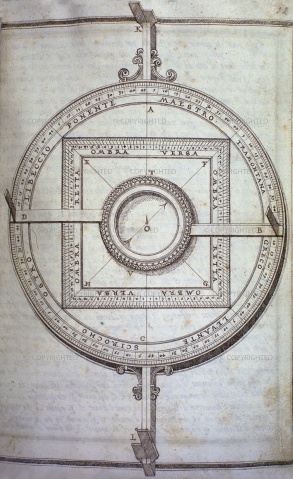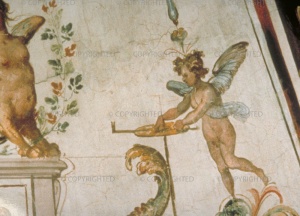Surveying Compass
From Inventions
| Line 1: | Line 1: | ||
{{Template invention | {{Template invention | ||
| - | |nome= | + | |nome= |
| + | Name currently used to distinguish the instrument used for surveying from the instrument of orientation also called [[compass]]. | ||
| - | |descrizione= | + | |descrizione= |
| + | Goniometric circle similar to the [[horizon]] of Leon Battista Alberti but equipped with diopter and magnetic needle. The circumference is divided into 8 sectors designating the directions of the winds (Tramontana, Greco, Levante, Scirocco, Ostro, Libeccio, Ponente, Maestro), and each part is divided generally into 45°, for a total of 360°. In Raphael’s famous letter to Pope Leo X (c.1515), containing a first description of this instrument, the suggested division is 4 degrees for each wind, for a total of 32 degrees. The position angle of a place is read in relation to the direction of the wind blowing from the sector of the circumference carrying the diopter. The instrument is named for the [[compass]] usually found at the centre of the graduated disc. | ||
|inventore= | |inventore= | ||
Revision as of 10:14, 12 November 2009
Name currently used to distinguish the instrument used for surveying from the instrument of orientation also called compass.
Contents |
Historic Period
15th-16th C.
Description
Goniometric circle similar to the horizon of Leon Battista Alberti but equipped with diopter and magnetic needle. The circumference is divided into 8 sectors designating the directions of the winds (Tramontana, Greco, Levante, Scirocco, Ostro, Libeccio, Ponente, Maestro), and each part is divided generally into 45°, for a total of 360°. In Raphael’s famous letter to Pope Leo X (c.1515), containing a first description of this instrument, the suggested division is 4 degrees for each wind, for a total of 32 degrees. The position angle of a place is read in relation to the direction of the wind blowing from the sector of the circumference carrying the diopter. The instrument is named for the compass usually found at the centre of the graduated disc.
Bibliographical Resources
Bartoli, Cosimo. Del modo di misurare le distantie, le superficie, i corpi, le piante, le provincie, le prospettive, & tutte le altre cose terrene, che possono occorrere a gli huomini..., Venezia, Francesco Franceschi, 1564.
Sanzio, Raffaello. Memoria a Leone X, in Raffaello Sanzio, Tutti gli scritti, a cura di Ettore Camesasca, Milano, Rizzoli, 1956, pp. 51-64.
Existing Instruments
Florence, Museo Galileo. Institute and Museum of the History of Science, inv. 154.
Florence, Museo Galileo. Institute and Museum of the History of Science, inv. 1279.
Florence, Museo Galileo. Institute and Museum of the History of Science, inv. 144.
Florence, Museo Galileo. Institute and Museum of the History of Science, inv. 3371.
Florence, Museo Galileo. Institute and Museum of the History of Science, inv. 2506.
Images
Antonio Santucci, Trattato di diuersi istrumenti matematici che si conseruano al presente nella Guardaroba del Gran Duca di Toschana presi in disegno in questo libbro, con le loro operazioni come in misurare le lunghezze, largezze, altezze ouero profondita, così delle cose terrene come celesti, similmente in leuar le piante delle prouincie o di qual si voglia cosa con ogni particolarità che giustamente stien ne luoghi loro, ms., 1593, Firenze, Biblioteca Marucelliana, Ms. C 82, c. 8a |
Antonio Santucci, Trattato di diuersi istrumenti matematici che si conseruano al presente nella Guardaroba del Gran Duca di Toschana presi in disegno in questo libbro, con le loro operazioni come in misurare le lunghezze, largezze, altezze ouero profondita, così delle cose terrene come celesti, similmente in leuar le piante delle prouincie o di qual si voglia cosa con ogni particolarità che giustamente stien ne luoghi loro, ms., 1593, Firenze, Biblioteca Marucelliana, Ms. C 82, c. 32a |
|
Author of the entry: Filippo Camerota




